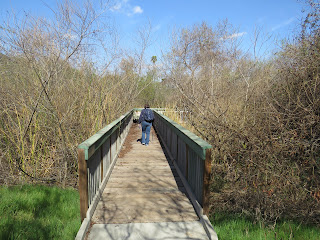By midday, the marine layer had evaporated to reveal mostly sunny skies as Caroline and I begin hiking in the 123-acre, Dana Natural Area in San Pedro, California, 26 miles south of Los Angeles. Shortly after leaving the trailhead, I’m not surprised to spot a Honeybee feeding on a Japanese Cheesewood blossom, a favorite attraction because of its sweet orange-like fragrance. Next, despite not seeing the Song Sparrow, I stop to enjoy its solo from a leafless Alder tree. During our time here, I’ve heard this pleasing song many times in many settings throughout this densely populated landscape and am amazed how well this bird adapts to such conditions. Just ahead, Caroline points out a 3-inch Fence Lizard, warming itself in the sun. Speaking of reptiles, we come upon a warning sign often seen on our hikes. After many years hiking in suitable habitat, I’m still longing for my first encounter with one of these creatures, likely a Western Diamondback (stock photo). After passing a Lodgepole Pine tree displaying both male and female cones and a Brazilian pepper tree displaying its red fruit, I pause to watch a flock of Cedar Waxwings feeding on cones high in an Alder tree. A common winter migrant here in Southern California, these birds will later travel to their summer breeding grounds in northern US and Canada. Beginning our steep ascent on a paved road, I come upon a field of dead Black Mustard stalks as well as an invasive Leafy Spurge plant. Near the hilltop, a plant restoration effort by the nature center reveals Lavender, Purple Sage and Creeping Thyme. Looping around and beginning our descent on an earthen trail, I spot a White Garden Snail clinging to a thistle leaf as well as small pink blossoms of Wild Radish and Stork’s Bill. Further down the hill, I first gaze afar to see a perching Says Phoebe and then crouch down to notice a tiny Ladybug feeding on mustard greens. After rejoining the paved road, we continue our descent against the backdrop of metropolitan San Pedro with a population of 57,000. Back in the car, we head to our Redondo Beach rental for afternoon quiet time.
Competition
Vying for space
Habitats for nature
Human case
Cooperation
Vying for space
Unity with nature
Human race
Conservation
Vying for space
Protection of nature
Human grace
D. DeGraaf



